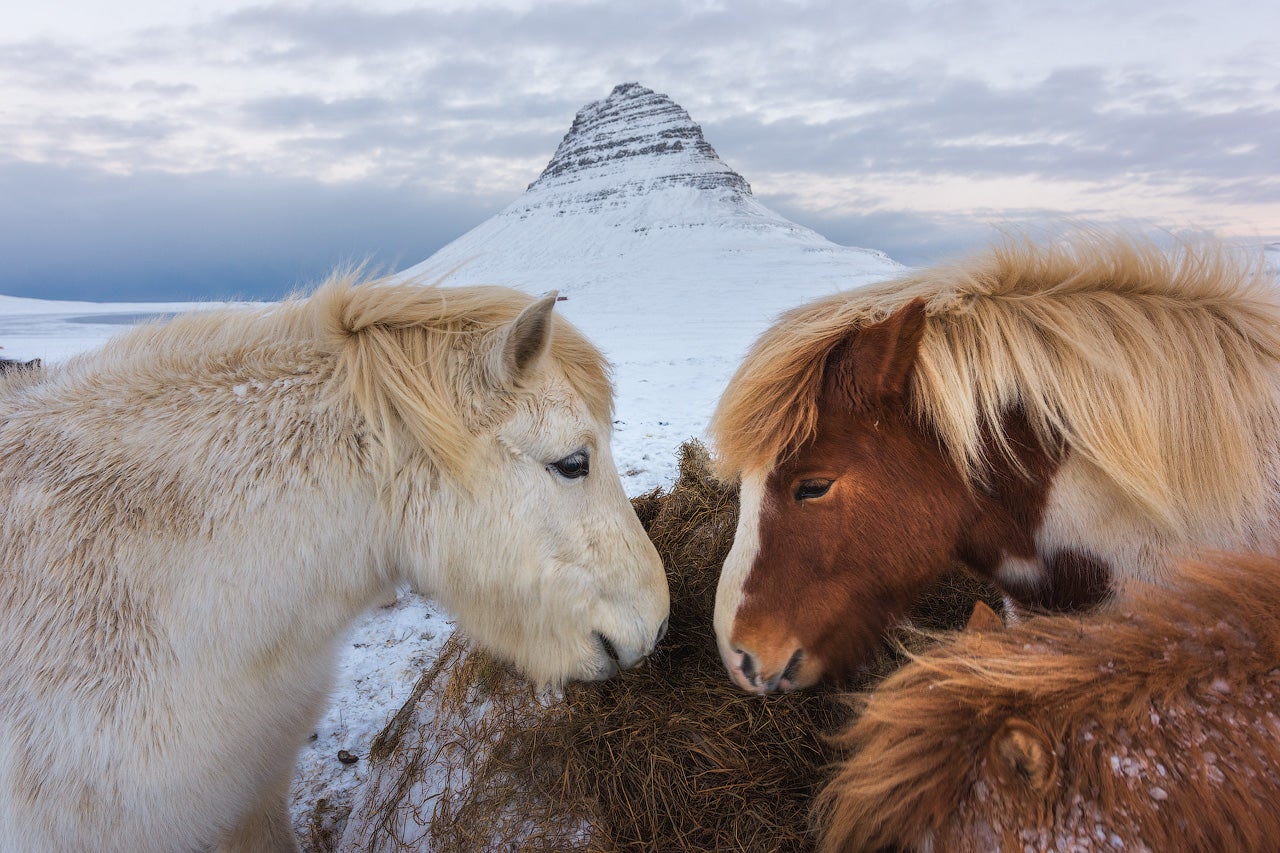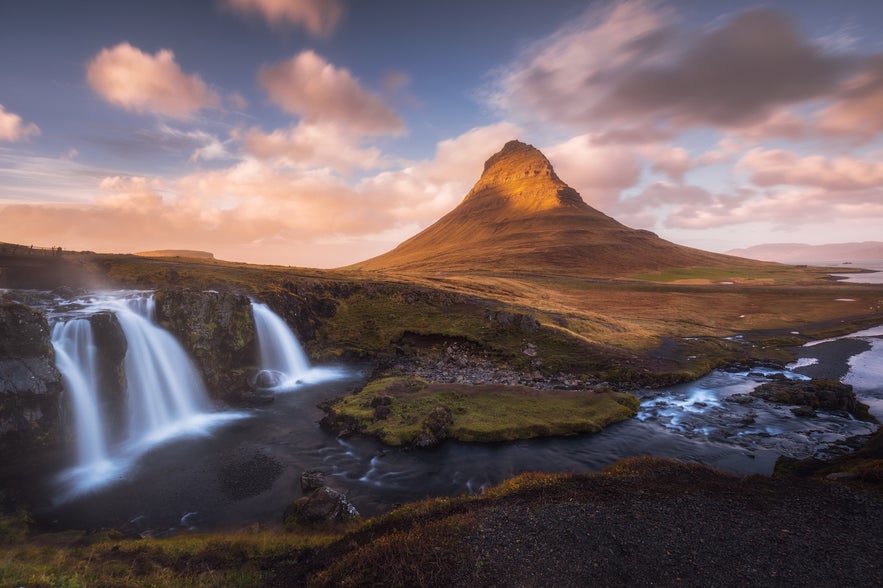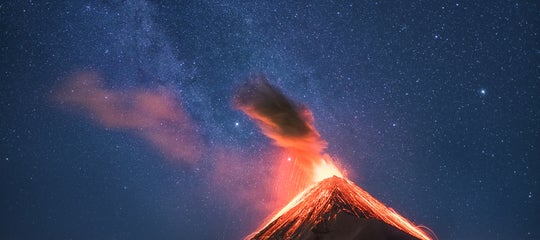
The Ultimate Field Guide to Photography at Kirkjufell in Iceland
- About Mount Kirkjufell and Kirkjufellsfoss
- Equipment You'll Need for Photography at Kirkjufell
- Best Camera Settings for Photographing Kirkjufell
- How to Compose a Photo of Kirkjufell and Kirkjufellsfoss
- The Best Times to Photograph Kirkjufellsfoss
- Winter
- Beneath the Northern Lights
- Autumn
- Photographing Kirkjufell During Bad Weather
- How to Find Kirkjufell and Kirkjufellsfoss?

Ah, Kirkjufell. It's perhaps the most widely recognised mountain in all of Iceland, as well as the most-photographed landmark in the country. Together with its waterfall, Kirkjufellsfoss, this scene makes for an incredibly beautiful sight. You may have seen many photos of this glorious wonder of nature already – some showing the mountain on its own, while others feature the waterfall flowing freely in the foreground. However, unless you have already done your research and know where Kirkjufell is located, it can be difficult to spot the classic composition that you probably want to capture for yourself.
- Learn about the Must Have Filters for Landscape Photography
- Check out this Private Golden Circle Photo Tour with Kerid Crater Lake
- Find out How to Use the Graduated Filter Tool for Landscape Photography
The fact is that the beauty of Kirkjufellsfoss waterfall is not something that may be immediately noticed from the road. Situated at the base of the mighty Kirkjufell mountain, this small but beautiful waterfall on the Snæfellsnes Peninsula makes for a captivating composition for landscape photographers when viewed from a certain angle. Once you find this angle though, the scene becomes one that will truly take your breath away.
About Mount Kirkjufell and Kirkjufellsfoss
The Kirkjufellsfoss waterfall flows forth from the Kirkjufellsá river and may be found just outside of the small town of Grundarfjörður in the west of Iceland. This beautiful five metre high cascade tumbles over a couple of levels and is divided into three separate spouts.
 Kirkjufell in Summer. Photo by: 'Iurie Belegurschi'.
Kirkjufell in Summer. Photo by: 'Iurie Belegurschi'.
There is a small path that leads between Kirkjufell and the waterfall itself. As you follow the path around, you'll find yourself standing on the other side of the waterfall, such that you are no longer between the two landmarks. Rather, you'll be gazing back at them, with the waterfall at your feet and the iconic pyramid-shaped mount Kirkjufell towering above.
The combination of Kirkjufell and its waterfall Kirkjufellsfoss is incredibly photogenic, which is why it probably attracts so many landscape photographers from far and wide. The clear, splendid water of Kirkjufellsfoss is greatly complemented by the majestic Kirkjufell in the background, throughout the seasons in the year. It's no wonder why this 463 metre tall mountain has been featured so prominently on the popular HBO TV series, 'Game of Thrones', as the extraordinary 'arrow head' mountain!
Equipment You'll Need for Photography at Kirkjufell
-
A reliable camera
-
Wide angle lens
-
Tripod
-
Graduated neutral density filters
-
Neutral density filters
-
Memory card
Conditions at Mount Kirkjufell may vary, so filters are not always required for landscape photography at this location. However, depending on the light, you may benefit from using graduated neutral density filters to balance the exposure between the sky and Kirkjufellsfoss in the foreground. You can also use neutral density filters to help you to create a longer exposure, which will make for silky and dreamy effects in the waterfall itself.

Whenever you take longer exposures, it is important to mount your camera onto a tripod. This will help you to minimise camera shake as you photograph Kirkjufellsfoss, especially if you'll be going for the smoothed-out water effect. You can also handhold your camera while you are taking photos of Kirkjufellsfoss, though you will most likely need to work with a faster shutter speed, meaning that you will capture more real-time texture of the water.
While it is not necessary to use a wide angle lens to photograph Kirkjufell and Kirkjufellsfoss, you may find that you'll need to take several photos to stitch together as a panorama when using a mid-range zoom lens. There are no clear uses for telephoto lenses here, unless you'll be taking abstract photos of the textures in the waterfall or the mountain itself.
Best Camera Settings for Photographing Kirkjufell
The difficulty with photographing Kirkjufellsfoss is that there is considerable distance between the waterfall in the foreground and Mount Kirkjufell in the background. For those who would like to capture the scene in just one shot, set your aperture to somewhere between f/14 and f/16 to ensure sharp front to back focus. However, you can also focus stack this scene to ensure that Kirkjufellsfoss as well as Kirkjufell in the background will be sharp.
When photographing Kirkjufellsfoss, your shutter speed will depend largely upon the effect that you would like to achieve. To freeze-frame the water, try shooting at a shutter speed of 1/125. For long exposure effects, you can even have your shutter open for a few minutes, with the use of neutral density filters.
 Kirkjufellsfoss beneath the Midnight Sun. Photo by: 'Iurie Belegurschi'.
Kirkjufellsfoss beneath the Midnight Sun. Photo by: 'Iurie Belegurschi'.
Using a tripod will ensure that you'll be able to adjust your ISO as low as it will go, which is usually around the 50-100 range for most digital cameras. A lower ISO will always help to minimise noise in your images. However, as we mentioned above, you'll need to use a higher ISO if you'll be handholding your camera. Somewhere between 400-800 will suffice. If the lighting is particularly dim, then you'll need to increase your ISO even further.
How to Compose a Photo of Kirkjufell and Kirkjufellsfoss
There are many different ways that you can compose Kirkjufellsfoss, though the most popular is from the front, with Kirkjufell planted firmly in the background. There is a path that you will be able to walk around on and the best spot to situate yourself is near the top, right by the bridge.
Although you may be tempted to stray from the path to explore the waterfall at a much closer distance, fences have been erected around the area to protect the delicate vegetation surrounding both Kirkjufell and Kirkjufellsfoss.
Try exploring the area and looking for reflections of Kirkjufell in little pools or puddles of water. It also pays to try shooting it from different angles, as you may be able to come up with a more unique composition than the otherwise traditional shot.
The Best Times to Photograph Kirkjufellsfoss
As we've already mentioned, Kirkjufell and its waterfall Kirkjufellsfoss are perhaps the most photographed landmarks in all of Iceland. Given that they have been featured on many postcards, advertisements and even on TV, you can expect this landscape photography location to be busy all year round, particularly in summer when tourists and photographers alike will visit en masse.
 Kirkjufellsfoss at sunset. Photo by: 'Iurie Belegurschi'.
Kirkjufellsfoss at sunset. Photo by: 'Iurie Belegurschi'.
As Kirkjufellsfoss makes for a great photo opportunity, it can get quite busy with visitors during the day, taking pictures, videos and selfies. In fact, it is even busy during the coveted time slots of sunrise and sunset, which have previously been reserved only for hardcore landscape photographers who are willing to forego breakfast and dinner! As such, the trick to capturing the perfect photo of Kirkjufellsfoss, with hardly anybody around, is to get to Kirkjufell at the right time.
Winter
During winter, Kirkjufell is particularly beautiful during twilight, when it is swathed in a pristine layer of snow and there are no footsteps to disturb the scene. However, this can sometimes mean that the rope fence is covered in snow also, making it dangerous for landscape photographers to be able to figure out how close to the edge they can actually get.
When in doubt, stand back, lest the ground should tumble away from beneath your feet.
 Winter at Kirkjufell. Photo by: 'Iurie Belegurschi'.
Winter at Kirkjufell. Photo by: 'Iurie Belegurschi'.
For safety purposes, it is also a good idea to wear crampons when visiting Kirkjufellsfoss in winter, as the path around the waterfall can get icy and slippery.
Also, keep in mind that although Kirkjufell and Kirkjufellsfoss will be quieter during the winter, they still manage to attract a lot of visitors. When possible, try shooting just before sunrise, when most people will still be cosy in bed. There will always be fewer visitors to Kirkjufell just before sunrise, as opposed to during sunset.
Beneath the Northern Lights
Kirkjufell is situated to the north of the Snæfellsnes Peninsula, making it the perfect place to witness the Northern Lights. As you can imagine, the mountain and its waterfall Kirkjufellsfoss look absolutely stunning with the Aurora Borealis dancing above, seemingly rising from the conical peak.
 Northern Lights at Kirkjufell. Photo by: 'Iurie Belegurschi'.
Northern Lights at Kirkjufell. Photo by: 'Iurie Belegurschi'.
Many people flock to Kirkjufell to take photos of it beneath the Northern Lights, so be mindful of others when you are there yourself. Always communicate with those around you to ensure that you are all on the same page, particularly in terms of using headlamps in the dark. This will minimise your own and others frustration when attempting to get the perfect shot.
For your best chances at seeing the Northern Lights over Kirkjufell and Kirkjufellsfoss, it's best to visit Iceland during autumn, spring or winter. There will be no chance of seeing the Northern Lights at Kirkjufell during summer, when the country experiences close to 24-hours of daylight. You'll need dark, clear skies and good solar activity to see the Aurora!
Autumn
One of the loveliest times to photograph Kirkjufellsfoss is during the autumn season, when the surrounding foliage takes on earthy hues. Wildflowers, moss and other vegetation turn brilliant shades of orange, red and gold, making for truly enchanting scenes.

Photographing Kirkjufellsfoss in fall during sunrise or sunset will yield extraordinary shots, as the warm glow of the sun will bring out the vivacity of the incredible landscape. However, these beautiful colours also make it possible to capture breathtaking photos of Kirkjufell and its waterfall during any other time of the day.
Of course, the Northern Lights return to the skies in autumn, so not only will you have the green lady dancing in the sky but you'll have the perfect foreground for it!
Photographing Kirkjufell During Bad Weather
We all know that the weather in Iceland can be very unpredictable, particularly on the windswept Snæfellsnes Peninsula. Even during the best of days, snow and fog can come from nowhere, making it impossible to see Kirkjufell and Kirkjufellsfoss, let alone to photograph them.
 Reflection of Kirkjufell. Photo by: 'Iurie Belegurschi'.
Reflection of Kirkjufell. Photo by: 'Iurie Belegurschi'.
However, these conditions can also make for unique and beautiful scenes. As such, try photographing the mountain and its waterfall during both good weather and the bad. It's worthwhile revisiting them at some point during your trip, even if you've already photographed them, as both Kirkjufell and Kirkjufellsfoss may look completely different underneath different lighting conditions.
Another benefit of photographing this iconic location during bad weather conditions is that most people will retreat to their cars or their hotels, leaving you alone to shoot in peace!
- See also: How to Take Great Photos in Bad Weather
How to Find Kirkjufell and Kirkjufellsfoss?
Kirkjufellsfoss is located at the base of Mount Kirkjufell on the Snæfellsnes Peninsula in west Iceland. There is a small parking lot at the base of the mountain, where you will find a walking path that goes around the waterfall itself. Follow the path up and over a bridge, before descending to the side of the waterfall. It may not seem completely clear from the parking lot but once you get to the side of Kirkjufellsfoss, you'll see how it is framed perfectly by Kirkjufell in the background.
Access is free to the public.
About the author: Serena Dzenis is a landscape photographer based in Iceland. You can find more of her work on her website or by following her on Facebook and Instagram.
Would you like to improve your photography skills in the beautiful surrounds of Iceland? Check out our range of photography tours and workshops which are designed to take your photography skills to a whole new level.
Other interesting articles

Complete Guide to Photography at Hraunfossar Waterfall in Iceland
There’s no doubt that Hraunfossar waterfall is one of the best places for photography in Iceland. Also known as the ‘Lava Falls’, this magical location is only a short detour between the Snæfellsnes...Read more
The Ultimate Guide to Photographing Ice Caves in Iceland
For most photographers who travel to Iceland, capturing the immense extraordinariness of the country’s ice caves is a once-in-a-lifetime experience that can be made disappointing without the right a...Read more
What is Aperture? An Introduction to Aperture in Photography
When you’re just starting out with photography it’s important to know how your camera works. Aperture is an important part of the exposure triangle (shutter speed, ISO and aperture). It partly deter...Read more





















